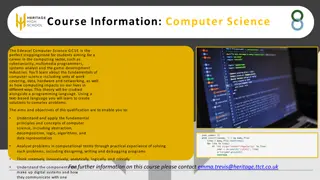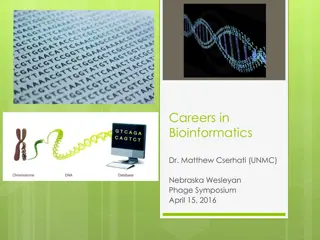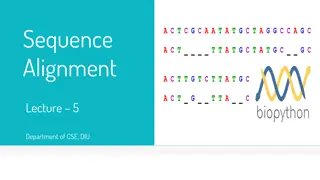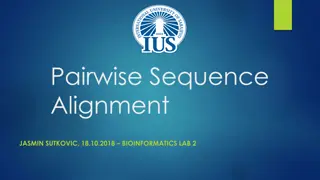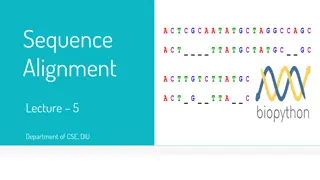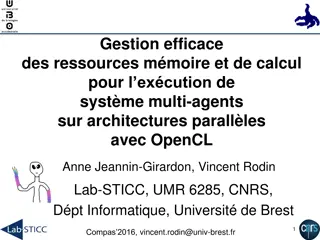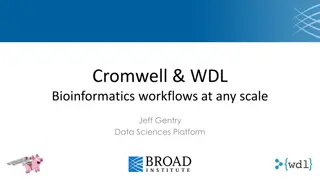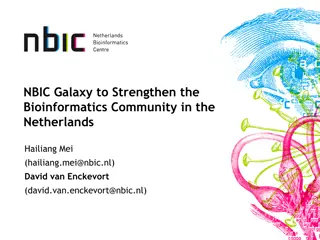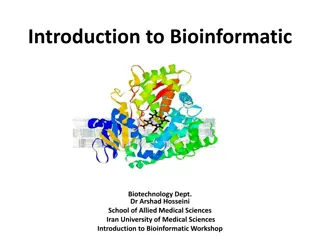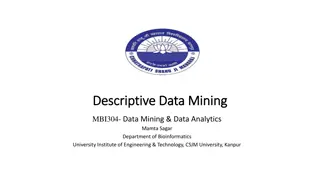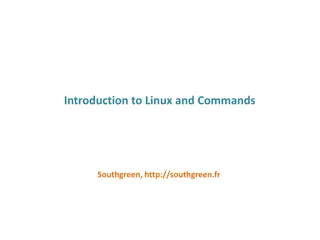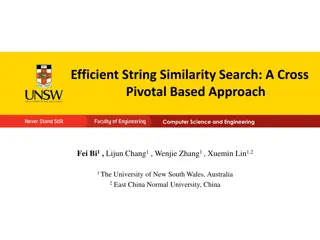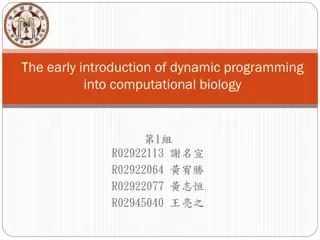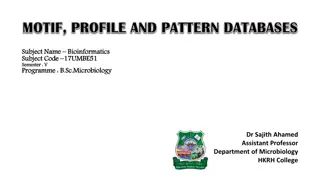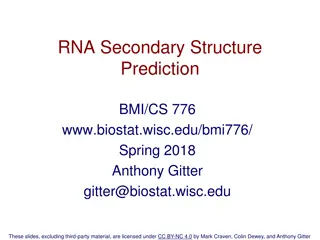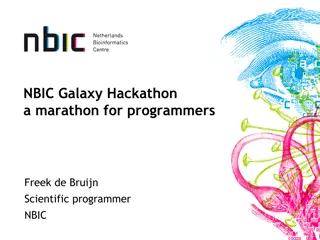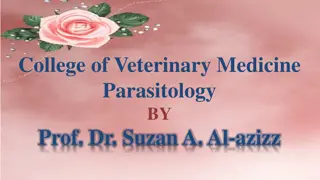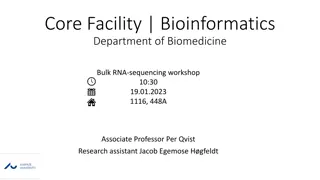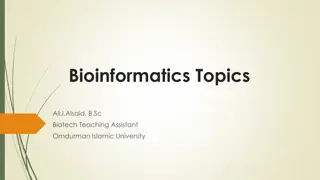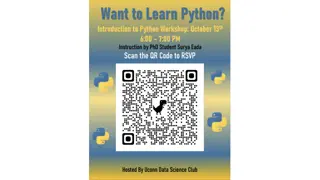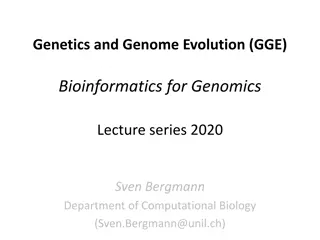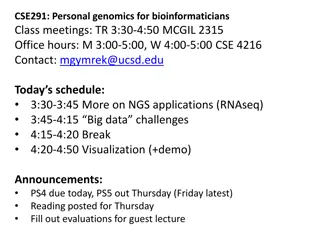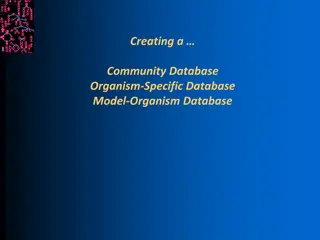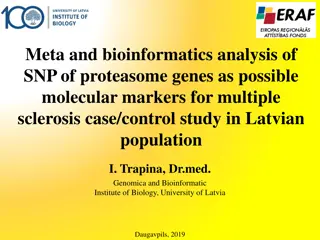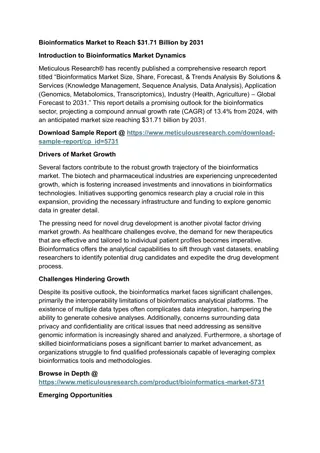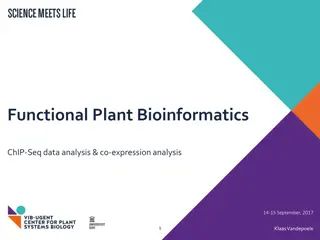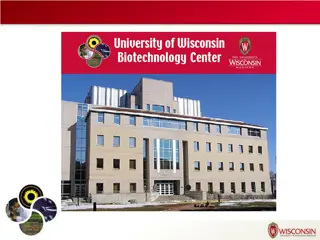Explore Edexcel Computer Science GCSE Course Information
The Edexcel Computer Science GCSE is an ideal pathway for students interested in a computing career, covering fundamental computer science principles, practical problem-solving using a programming language, and understanding digital systems. The course focuses on developing creativity, analytical th
1 views • 4 slides
Understanding Molecular Docking in Bioinformatics
Explore the world of molecular docking in bioinformatics through in silico approaches, learning about protein-ligand interactions, modes of docking, different docking approaches, and the theory of enzymes. Discover how this computational method helps predict the binding affinity and conformation of
4 views • 41 slides
Understanding Longest Common Subsequences in Bioinformatics
DNA Sequence Alignment is a crucial task in bioinformatics, where dynamic programming helps in finding the best alignment between DNA strings efficiently. The Longest Common Subsequence (LCS) problem aims to discover the longest shared subsequence between two strings, offering applications in DNA si
1 views • 21 slides
Bioinformatics
Bioinformatics involves analyzing biological sequences through sequence alignment to uncover functional, structural, and evolutionary insights. This process helps in tasks like annotation of sequences, modeling protein structures, and analyzing gene expression experiments. Basic steps include compar
0 views • 6 slides
Bioinformatics for Genomics Lecture Series 2022 Overview
Delve into the Genetics and Genome Evolution (GGE) Bioinformatics for Genomics Lecture Series 2022 presented by Sven Bergmann. Explore topics like RNA-seq, differential expression analysis, clustering, gene expression data analysis, epigenetic data analysis, integrative analysis, CHIP-seq, HiC data,
0 views • 36 slides
Exploring Bioinformatics: Careers, Research, and Disciplines
Bioinformatics is an interdisciplinary field combining biology, computer science, mathematics, and statistics. Dr. Matthew Cserhati, a bioinformatics programmer, has a background in biology and software engineering. His research includes projects like NeuroAIDS database development and Staphylococcu
2 views • 46 slides
Exploring the World of Bioinformatics Databases
Bioinformatics databases are essential tools in handling molecular biological data, classified into sequence and structure databases. Primary databases store raw data, while secondary databases contain curated information for research. Examples include GenBank, Protein Data Bank, and SWISS-Prot.
1 views • 38 slides
Gene Prediction: Similarity-Based Approaches in Bioinformatics
Gene prediction in bioinformatics involves predicting gene locations in a genome using different approaches like statistical methods and similarity-based approaches. The similarity-based approach uses known genes as a template to predict unknown genes in newly sequenced DNA fragments. This method in
1 views • 40 slides
An Overview of Biological Databases in Bioinformatics
Biological databases play a crucial role in bioinformatics, storing vast amounts of data related to nucleotide sequences, protein sequences, and more. These databases are publicly accessible and essential for research in biological fields. Primary databases, such as GenBank, EMBL, and DDBJ, contain
0 views • 13 slides
Understanding Sequence Alignment in Bioinformatics
Explore the significance of aligning DNA, RNA, and protein sequences for identifying similarities and relationships. Learn about pairwise and multiple alignment methods like Needleman-Wunsch and Smith-Waterman, and how they help in discovering functional, structural, and evolutionary connections bet
0 views • 14 slides
Understanding Sequence Alignment and Tools in Bioinformatics
Explore the concepts of homology, orthologs, and paralogs in bioinformatics, along with different types of sequence alignment such as global, local, and semi-global. Learn about popular alignment tools like Blast and Fasta and how they are used for analyzing sequences. Dive into the world of NCBI an
0 views • 32 slides
Understanding Sequence Alignment Methods in Bioinformatics
Sequence alignment is crucial in bioinformatics for identifying similarities between DNA, RNA, or protein sequences. Methods like Pairwise Alignment and Multiple Sequence Alignment help in recognizing functional, structural, and evolutionary relationships among sequences. The Needleman-Wunsch algori
0 views • 18 slides
Understanding Sequence Alignment in Bioinformatics
Sequence alignment in bioinformatics involves arranging DNA, RNA, or protein sequences to identify similarities for functional, structural, and evolutionary insights. It helps in comparing genes, proteins, and discovering conserved regions, highlighting the importance of global and local alignment m
0 views • 19 slides
Efficient Resource Management for Multi-Agent System Execution on Parallel Architectures with OpenCL
This research focuses on efficiently managing memory and computing resources for executing multi-agent systems on parallel architectures using OpenCL. The study presents a hybrid approach involving population-level molecular virtual chemistry and individual-level virtual cells. The work enhances a p
1 views • 33 slides
Explore Cromwell and WDL Bioinformatics Workflows
Discover the world of Cromwell and WDL bioinformatics workflows at any scale, with emphasis on the scalability and flexibility of the execution engine. Learn about the Workflow Description Language and basic plumbing concepts. Unveil the multiple backends for maximum flexibility in Cromwell's execut
0 views • 14 slides
GPU Accelerated Algorithm for 3D Delaunay Triangulation
Thanh-Tung Cao, Todd Mingcen Gao, Tiow-Seng Tan, and Ashwin Nanjappa from the National University of Singapore's Bioinformatics Institute present a GPU-accelerated algorithm for 3D Delaunay triangulation. Their work explores the background, related works, algorithm implementation, and results of thi
0 views • 24 slides
Strengthening the Bioinformatics Community in the Netherlands
NBIC Galaxy, in collaboration with BioAssist, plays a pivotal role in bolstering the bioinformatics community in the Netherlands. With a focus on training, collaboration, and sharing tools, Galaxy enables scientists to leverage national HPC infrastructures for analysis, further enhancing research ca
0 views • 17 slides
Exploring Bioinformatics: Applications and Significance in Biotechnology
Bioinformatics involves the analysis of molecular biology data using information systems, computer science, and other techniques. It plays a crucial role in various fields like disease prevention, treatment, animal modeling, forensic analysis, and more, aiming to improve the quality of life and enha
0 views • 17 slides
Understanding Data Mining and Analytics in Bioinformatics
Data mining in bioinformatics involves descriptive analysis of statistical attributes, creating predictive models, and empirically verifying them. By employing algorithms from various fields, data mining helps in tasks like classification, clustering, association analysis, and regression. The proces
0 views • 14 slides
The Power of Unix Command Line Basics for Text Processing in Bioinformatics
Unix Shell commands such as sort, cut, uniq, join, paste, sed, grep, awk, wc, diff, comm, and cat are essential for text processing in bioinformatics. These tools allow seamless manipulation of text data without the need for intermediate files, making file processing efficient and powerful. By pipin
0 views • 19 slides
Overview of Perl Programming: Features, Popularity, and Learning
Perl is a versatile scripting language suitable for various tasks such as test processing, system administration, and bioinformatics. Despite a decline in popularity due to the rise of languages like PHP and Python, Perl remains useful and easily accessible on different platforms. Learning Perl requ
0 views • 24 slides
Introduction to Linux and Commands - Overview and Benefits
Linux is a powerful operating system with roots in UNIX, offering a wide array of functionalities for users. The program goals include presenting the Linux OS basics, introducing fundamental command-line operations, and showcasing the utilization of bioinformatics software. The content explores the
0 views • 79 slides
Efficient String Similarity Search: A Cross Pivotal Approach in Computer Science and Engineering
Explore the importance of string similarity search in handling dirty data, with applications in duplicate detection, spelling correction, and bioinformatics. Learn about similarity measurement using edit distance and the challenge of time complexity in validation. Discover the filter-and-verificatio
0 views • 30 slides
The Early Introduction of Dynamic Programming in Computational Biology
The early integration of dynamic programming in computational biology, spearheaded by David Sankoff, revolutionized sequence comparison, multiple alignment, and phylogeny analyses. Sankoff's pioneering work in the 1970s laid the foundation for bioinformatics, recognizing the key role of algorithm de
0 views • 34 slides
Understanding Motifs in Bioinformatics
Bioinformatics studies the patterns of sequences called motifs, which play significant roles in biological functions. Conserving information from DNA or proteins, motifs can be predicted de novo using various tools and strategies. Exploring these motifs aids in understanding regulatory elements and
0 views • 15 slides
Exploring RNA Secondary Structure Prediction in Bioinformatics
RNA secondary structure prediction is a key concept in bioinformatics, encompassing features like stems, loops, and bulges. This presentation delves into the importance of RNA beyond mRNA, highlighting rRNA, tRNA, and regulatory RNA roles. The canonical base pairs A-U and C-G shape the single-strand
0 views • 20 slides
Insights from NBIC Galaxy Hackathon: Building Community and Learning Experiences
NBIC Galaxy Hackathon, a marathon for programmers, brought together bioinformatics experts and programmers to collaborate on innovative projects. The event showcased the community-building efforts, technological advancements, and learning experiences gained through modifying Galaxy, a bioinformatics
0 views • 9 slides
Exploring Whales and DNA through Bioinformatics Adventures
Dive into a fascinating journey through scenarios involving whale bones, wildlife crimes, and DNA mysteries. Uncover the secrets of mitochondrial DNA and bioinformatics in an interactive webquest. Join the experts Jayne Ricciardi, Beth Marass, and special guest Katie Lodes in this educational expedi
0 views • 4 slides
Understanding Parasitology in Veterinary Medicine by Prof. Dr. Suzan A. Al-azizz
Parasitology is a vital study of parasites and their hosts, encompassing various disciplines like cell biology, bioinformatics, genetics, and ecology. This field emphasizes the binomial system of species naming pioneered by Linnaeus. The essence of human scientific naming is exemplified by Homo sapi
0 views • 16 slides
Bioinformatics Core Facility at Aarhus University: Services and Contact Details
The Bioinformatics Core Facility at Aarhus University offers bioinformatics training, consultation, data analysis, research collaboration, and more services for scientists. They provide expertise in NGS analyses, data formatting, knowledge dissemination, and pricing models. Contact them for bioinfor
0 views • 32 slides
Overview of Bioinformatics Topics in Informatics and Biology
Bioinformatics covers various topics such as informatics, biology, programming, statistics, and operating systems. It emphasizes the importance of skills in data management, programming, and statistical analysis for interpreting experimental data types like DNA sequencing and protein structures.
0 views • 55 slides
Efficient Ways to Download Genome Files for Bioinformatics Analysis
Obtain valuable insights into retrieving genome files for bioinformatics analysis utilizing multiple methods such as connecting via Finder, using Filezilla for FTP access, and executing curl commands on Xanadu. Learn how to access coding sequences, feature tables, nucleotide sequences, and encoded p
0 views • 38 slides
Understanding Genomics and Bioinformatics in Genetics Evolution
Delve into the world of genomics and bioinformatics through the Genetics and Genome Evolution (GGE) lecture series by Sven Bergmann. Explore topics such as RNA-seq analysis, differential expression, gene expression measurement techniques, and integrative analysis with epigenetic data. Gain insights
0 views • 37 slides
Understanding NGS Applications in Bioinformatics
Explore the world of Next-Generation Sequencing (NGS) applications in bioinformatics, covering topics such as RNA sequencing, big data challenges, storing genomic datasets, querying genetic information, and data visualization. Dive into the complexities of sequencing technologies, gene expression co
0 views • 41 slides
Creating a Model Organism Database: The Importance and Process
In the realm of bioinformatics, the creation of Model Organism Databases (MODs) plays a crucial role in advancing genomic research and understanding the complexities of various organisms. MODs facilitate pathway analyses, omics data analysis, and the development of metabolic models, serving as valua
0 views • 17 slides
Analysis of Proteasome Gene SNPs as Molecular Markers for Multiple Sclerosis in Latvian Population
This study by I. Trapina aims to investigate the prevalence and functionality of SNPs in proteasome genes to assess their potential as molecular markers for multiple sclerosis in the Latvian population. Multiple sclerosis is an autoimmune disease affecting the central nervous system, and the role of
0 views • 13 slides
Bioinformatics Market
Bioinformatics Market Size, Share, Forecast, & Trends Analysis By Solutions & Services (Knowledge Management, Sequence Analysis, Data Analysis) Application (Genomics, Metabolomics, Transcriptomics) Industry (Health, Agriculture) \u2013 Global Forecas
1 views • 6 slides
Plant Bioinformatics Studies on ChIP-Seq Data Analysis
Plant bioinformatics researchers conducted experimental analyses and mapped gene regulatory networks using ChIP-Seq data. The studies involved exploring gene expression, regulatory interactions, and transcription factor binding sites. Techniques such as peak calling, motif finding, and peak annotati
0 views • 19 slides
University of Wisconsin Biotechnology Center Overview
The University of Wisconsin Biotechnology Center (UWBC) is a leading institution employing approximately 60 faculty, staff, and students. Offering core facilities such as the Bioinformatics Resource Center and DNA Sequencing Core, UWBC provides services in next-gen sequencing data analysis, genome a
0 views • 12 slides
Emerging Trends in Bioinformatics: Leveraging CUDA and GPGPU
Today, the intersection of science and technology drives advancements in bioinformatics, enabling the analysis and visualization of vast data sets. With the utilization of CUDA programming and GPGPU technology, researchers can tackle complex problems efficiently. Massive multithreading and CUDA memo
0 views • 32 slides
